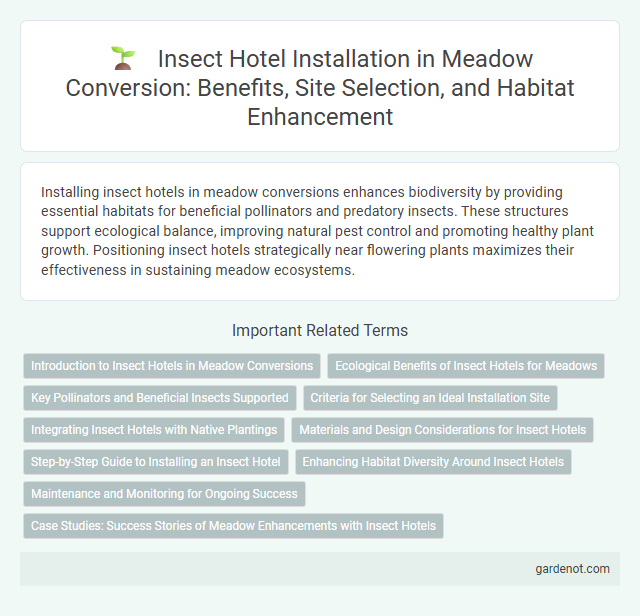Installing insect hotels in meadow conversions enhances biodiversity by providing essential habitats for beneficial pollinators and predatory insects. These structures support ecological balance, improving natural pest control and promoting healthy plant growth. Positioning insect hotels strategically near flowering plants maximizes their effectiveness in sustaining meadow ecosystems.
Introduction to Insect Hotels in Meadow Conversions
Insect hotels provide essential habitats for pollinators and beneficial insects in meadow conversions, enhancing biodiversity and ecosystem health. These structures support native insect populations by offering shelter, breeding sites, and protection from predators and harsh weather. Integrating insect hotels into meadow restoration promotes natural pest control and improves pollination efficiency, contributing to sustainable landscape management.
Ecological Benefits of Insect Hotels for Meadows
Insect hotels provide critical habitats for pollinators and beneficial insects that support meadow biodiversity and enhance natural pest control. These structures increase insect diversity and abundance, promoting healthy plant reproduction and soil health through improved pollination and organic matter decomposition. Installing insect hotels in meadow conversions fosters a balanced ecosystem, boosting resilience and overall ecological function.
Key Pollinators and Beneficial Insects Supported
Installing insect hotels in meadow conversions significantly boosts populations of key pollinators such as bees, butterflies, and hoverflies, which are essential for maintaining plant biodiversity. These structures provide vital nesting and overwintering habitats for beneficial insects, including solitary bees and predatory beetles, enhancing natural pest control. Supporting diverse beneficial insect species through insect hotels improves pollination rates and contributes to ecosystem resilience in restored meadow environments.
Criteria for Selecting an Ideal Installation Site
Selecting an ideal site for insect hotel installation in a meadow requires considering factors such as sunlight exposure, proximity to flowering plants, and shelter from strong winds. Optimal locations provide a balance of warmth and moisture, ensuring diverse insect species can access the habitat for nesting and foraging. Avoid areas with heavy pesticide use or frequent human disturbance to promote a thriving insect population and enhance meadow biodiversity.
Integrating Insect Hotels with Native Plantings
Integrating insect hotels with native plantings enhances biodiversity by providing essential habitats for pollinators and beneficial insects directly within meadow conversions. Native plants attract specific insect species, while strategically placed insect hotels offer shelter and breeding sites, promoting healthy ecosystems and improving pollination. This synergy supports sustainable meadow restoration by fostering resilient insect populations and enriching soil health.
Materials and Design Considerations for Insect Hotels
Insect hotel installation requires selecting natural materials like untreated wood, bamboo, straw, and hollow stems to create diverse nesting habitats for pollinators and beneficial insects. Design considerations focus on varied compartment sizes, moisture control, and protection from predators to mimic natural environments effectively. Proper placement in sunny, sheltered spots enhances insect activity, supporting meadow biodiversity and ecological balance.
Step-by-Step Guide to Installing an Insect Hotel
Choose a suitable location for the insect hotel, preferably a sunny, sheltered spot near the meadow to provide shelter and easy access to food. Construct the frame using untreated wood, then fill compartments with materials such as hollow stems, pine cones, bark, and dry leaves to attract various beneficial insects. Secure the insect hotel firmly to prevent movement and monitor it regularly to ensure it remains clean and inviting for pollinators and pest controllers.
Enhancing Habitat Diversity Around Insect Hotels
Installing insect hotels in meadow conversions significantly enhances habitat diversity by providing shelter and breeding sites for pollinators, predatory insects, and decomposers. Strategic placement near native wildflowers and grasses supports ecological interactions and increases local biodiversity. Incorporating varied materials such as wood, bamboo, and hollow stems caters to different insect species, promoting a balanced and resilient ecosystem.
Maintenance and Monitoring for Ongoing Success
Regular maintenance of insect hotels involves removing debris, repairing damaged structures, and replacing worn materials to ensure a safe habitat for beneficial pollinators and predatory insects. Monitoring insect activity helps track species diversity and population health, providing insights for adaptive management strategies that enhance ecosystem balance. Consistent upkeep supports the longevity of insect hotels, promoting thriving biodiversity within meadow conversions.
Case Studies: Success Stories of Meadow Enhancements with Insect Hotels
Case studies on meadow conversion reveal that installing insect hotels significantly boosts pollinator diversity and abundance, contributing to improved ecosystem health. Insect hotels provide essential nesting habitats for solitary bees and beneficial insects, increasing pollination rates by up to 40% in restored meadows. These success stories demonstrate measurable improvements in plant reproduction and biodiversity, validating insect hotels as a key component in meadow enhancement strategies.
Insect hotel installation Infographic

 gardenot.com
gardenot.com